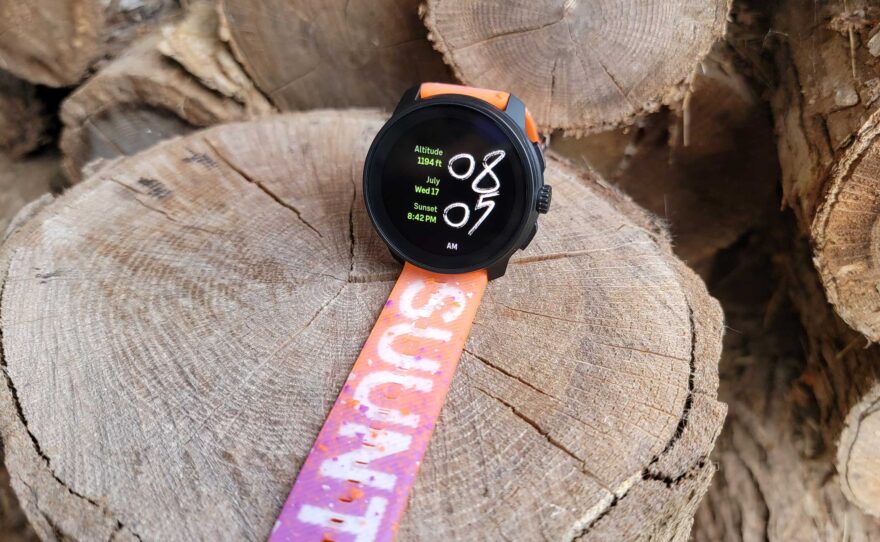
The Suunto Race S debuted on June 25, 2024. (Image by Ryan Tipps)
The compact Suunto Race S delivers impressive battery life in conjunction with maps, dual-frequency GPS tracking, an updated HR sensor and a vibrant AMOLED display.
Having used a Suunto as my primary sport watch for the past several years, I was excited to get my hands on the Suunto Race S soon after it launched in late June. This compact AMOLED-display device encapsulates some of the best GPS accuracy and build quality on the market, at a price point that is highly competitive.
I’ve been using the Suunto Race S for the past five weeks. It’s a loaner from the company, but this writeup is not sponsored, and I’ll be sending the watch back to Suunto very soon.
I wrote about the Race S when it was announced, and I delved into some of the key features: the latest testing puts the it at around 30 hours of GPS tracking on dual-frequency mode, it has a steel body with Gorilla glass, it added a better heart-rate monitor, and it is targeted toward trail runners who have smaller wrists or simply prefer a smaller form factor. (You can read that full article here.)
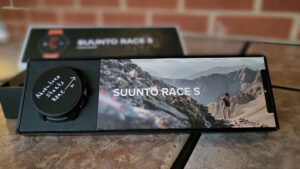
The Race S has slim, minimalist packaging, using entirely recycled paper. (Image by Ryan Tipps)
Beyond our news piece, there were numerous reviews of the Race S that were shared at that time, so I don’t want to rehash ground that has already been extensively covered. Instead, we can look at a few key things to help you decide if the Race S lives up to the hype (yes, almost every review is glowing about this watch!), how it matches expectations and whether it’s worth it to switch from another brand or to upgrade an aging Suunto.
With that in mind, here are five takeaways about the Suunto Race S after more than a month of testing across different environments, various activities and multiple states in the U.S.
1. What is the GPS Accuracy Like?
Let’s start with some background. Shortly before the launch of the Suunto Vertical adventure watch in early 2023, reviewer the5krunner touted it as the most accurate GPS watch ever — and not by a small margin either! I have worn a Vertical since it launched, and I’ve run past ½ mile markers on forest service roads and paved Greenways where the Vertical matches the marked distance either perfectly or within 0.01 miles. And that’s consistently dialed in over a span of several miles.
So, I did more than a dozen runs with the hyper-accurate Vertical on one wrist and a Race S on the other. Simply put: I liked what I saw.
In one of my more difficult runs, I climbed nearly 1,400 feet that the Vertical measured out to be 7.01 miles, while the Race S almost matched it at 7.02 miles. There was 35-foot different in the elevation the watches calculated.
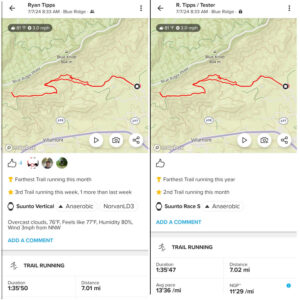
Another trail run again showed the watches just 0.01 miles apart at 6.19 for the Race S and 6.20 for the Vertical. This time, the elevation difference was just 1 foot.
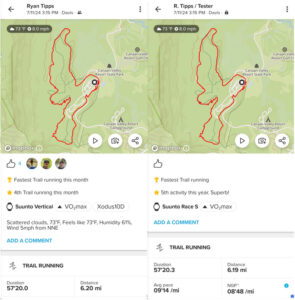
On the road, things looked even better, with this sample run coming it at 4.41 miles on both devices, though the elevation gain differed at 457 and 439 feet.
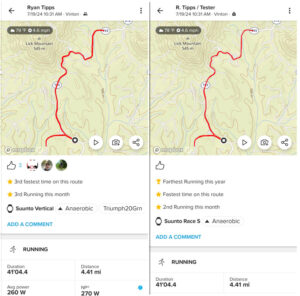
As an endurance runner, the reality is that I shouldn’t focus all that much on the minutia of distance measurements — after all, I’m not a podium runner, so if my watch measures my 40-mile race at 39.7 or 40.5, it’s not a big deal (how accurate are the officially listed distances at these events anyway?).
The comfort here is that when a watch is this accurate on a normal day, that means I’m less likely going to fret over potential deviations I’d get on cloudy days or during tree-covered activities. And with the Race S, I definitely have that kind of confidence in its GPS measurements.
(One final note: I would’ve liked to have tested this watch on longer runs, but I’ve been fighting an Achilles injury for more than eight months, so my training has been limited.)
2. Is it Built to Stay in the Game?
A lot has been said about the materials of the Race S when it debuted. Simply put, this may be the most beautifully built watch I’ve ever worn. The styling perfectly blends active and professional lifestyles — the fit and finish of the steel casing is something to behold. Calling it sleek is an understatement.
Additionally, the buttons and the functionality of the crown round out the elite user experience. Notably, the crown was easy to spin with one finger, even with my off hand, but it also has enough resistance to not spin unintentionally. Couple that with the peace of mind from screen-locking function that was ushered in with the Race S, and there a lot here to gravitate toward.
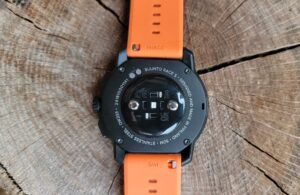
The Suunto Race S is made in Finland. (Image by Ryan Tipps)
I am pleased that most of the units produced for U.S. and European markets will be manufactured in Finland (the previous Suunto device, the standard Race, was made in China). While that may be a characteristic that is more impactful in name than in practice, it’s meaningful to me as a consumer.
At launch, the Race S was available with a steel body and Gorilla Glass, which does feel like a step down in materials from past Suunto watches that had made sapphire glass a standard (these material changes certainly were factors in the competitive price point). Rumors persist that a titanium version of the Race S will be available later in 2024, but no official word has come from Suunto about that.
In almost all situations, the Gorilla Glass wasn’t an issue, but having had this material in another brand of watch years ago, I understand its limitations. The only instance I didn’t feel comfortable wearing the Race S was while rock climbing in West Virginia, where I worried that contact with the steel carabiners or the jagged face of the mountain itself could potentially damage the screen. (I did promise to send this watch back to Suunto, after all.) So I donned my Vertical instead.

I chose to wear the Vertical instead of the Race S while climbing the Via Ferrata route in West Virginia. (Image by Ryan Tipps)
3. The New Generation of AMOLED Displays
Most sports watches on the market in recent years have had transflective MIP displays, but that took a major turn in 2023 with Suunto releasing the Race and Race S, Polar coming off the Ignite 3 and launching the Vantage V3, and Garmin updating its lineup with the Epix Pro. All of these have vibrant AMOLED displays, made possible for the sport-watch segment by major improvements in battery life capabilities.
And many in the sports and tech world have praised this innovation, pointing to AMOLED being the new standard for these devices.
AMOLED on its own isn’t new of course. I had a “super AMOLED” Samsung smartwatch back in 2017, but for a long time, the battery impact of this type of display ruined many of the endurance and sport capabilities of this and other similar devices.
So, let’s just say I went into things with the Race S more skeptical than most people would. And there was more to it than just the battery.
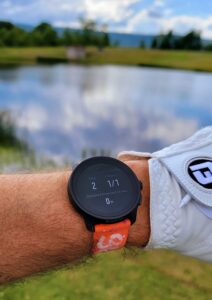
Nope, I didn’t get a hole in one — just started the Golf SuuntoPlus sports app late. (Image by Ryan Tipps)
When I had my Samsung watch (a Gear S3), the display setting that would “wake up” whenever I moved my wrist was insanely bright — detrimentally so. It was embarrassing in places like movie theaters and distracting while driving at night. I hated it. I have some sensitivities in my eyes, and the display was uncomfortable to look at.
From that perspective, the Race S is a marked improvement. When it wakes, the key elements of the watch face certainly become crisp and bright, but the face as a whole doesn’t become obnoxious. Raise to wake doesn’t dominate a dark room, and for that, I am thankful.
Another longtime complaint of AMOLED displays in comparison to MIP displays is their readability in bright sunlight. I’ve seen many top tech reviewers say how impressed they are with Suunto’s delivery in the Race lineup, so I came into the Race S with some positive expectations about how AMOLED works in daylight.
Well …
You can see in the photo below that even when the full AMOLED display is engaged, the screen doesn’t come close to holding its own against the MIP display of the Vertical. It’s legible, but if the activity in question is fast-paced or jarring (like on a trail run), then reading the AMOLED display of the Race S can be difficult.
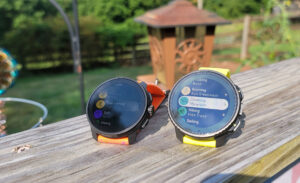
An AMOLED display in the Race S (left) versus a MIP display in the Vertical. (Image by Ryan Tipps)
Also of note is that I typically had the time visible in always-on mode, but that means that the screen spends most of its time very dim, only coming on when it sensed my wrist flick. The reason AMOLED displays have to do this is to avoid screen burn-in, but that also means there is inevitably a delay as the watch goes from dim to full brightness when you want to look at it.
That’s never really an issue during daily wear, but I did find it unpleasant during activities where I was on uneven, rocky or otherwise difficult terrain. That split second doesn’t sound like it would be an issue, but as a trail runner dodging trip hazards, I don’t spend a lot of time looking at my watch while I’m moving — I want a quick glance and then back to the terrain. A MIP display is unquestionably better suited to a situation like this than an AMOLED display is.
It is worth noting, however, that the maps on the Race S look absolutely amazing in AMOLED, even something that this colorblind writer appreciated.
4. Great Hardware, but What About Firmware?
Beautifully well-built watches have long made Suunto stand out against other brands, but as a small company, there has been concern about the amount of resources Suunto can dedicate to firmware development.
In short, the basic functionality has always been there, encapsulated by a Nordic simplicity in delivery. Yet, many people have yearned for more complexity.
There’s no doubt that the Race S is the most complex sport watch Suunto has ever made, and in several weeks of testing, I’ve encountered zero notable issues.
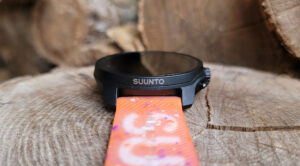
The Suunto Race S (Image by Ryan Tipps)
The Suunto firmware has been stable for me — in fact, over the past few years of using Suunto products, I can remember only two crashes ever in this brand’s devices, and none were in the past two years. (One of those crashes was in a Suunto 5 Peak that I bought off someone on Reddit, and Suunto support was fantastic, replacing the device with a new one even though I had no receipt, warranty information, or actual proof of purchase.)
The Race S has a new heart-rate sensor and carries over many internal algorithms that were launched with the standard Race, as well as new features such as climb guidance, sleep stages and nap detection. The SuuntoPlus store also continues to grow more robust and useful (weather, drink reminders, cadence coach and safe are the ones I use the most).
One monkey that Suunto has struggled to get off its back is regarding lag in its watches. The Race S and other devices on Suunto’s current firmware have received periodic updates, sometimes listing “faster interface” or “faster UI browsing” in the release notes. Bottom line, I don’t notice any lag that impacts performance in any way.
The newest generation of Suunto devices have greatly improved upon the 5 series or the 9 series, which would lag during day-to-day use. Today, anyone who complains about the lag on the Vertical or Race series is intentionally being a troll, and that kind of divisiveness just isn’t worth paying attention to.
5. Battery Life Has Gotten Good — But How Good?
It’s hard to talk about any kind of sport watch these days without steering into discussions of battery life. The reason that Coros burst onto the scene so intensely in the past five years is precisely because everyone boasted about the “insane” battery life of that brand’s watches.
However, one can reasonably argue that Suunto has wrestled that title away from Coros over the past year and a half.
The Race S legitimately packs a lot of battery power into such a small device, though it’ll be naturally less than the larger-sized standard Race and the larger and MIP-display Vertical.
As a long-time Vertical user, it was a bit of an adjustment to think about charging my watch more, but it’s also worth recognizing that I sometimes switch back to my old 9 Baro, which needs to go on the charger about every five days, so more frequent charging isn’t a deal-breaker.
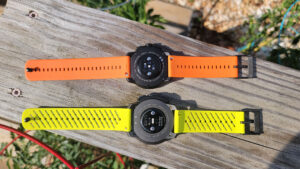
The Suunto Race S and Suunto Vertical side-by-side. (Image by Ryan Tipps)
Suunto told ActionHub that its latest testing puts the Race S at around 30 hours of GPS tracking on dual-frequency mode, which far outshines its competitors. For example, Garmin’s AMOLED Forerunner 965 is much larger and pricier but gets only 19 hours of GPS tracking in dual-band, while the more budget-conscious Forerunner 265 gets just 14 hours.
Yet, even if you find yourself needing a few extra hours for a 100-miler, the Race S can be customized to extend the battery — it delivers Endurance and Ultra modes, which automatically adjust things like power output and satellite settings, while still giving GPS readings at one-second intervals. Then there’s the aggressive Tour battery mode, which provides five days of tracking, but at extended intervals and best suited to slow-moving adventures.
Due to my pesky injury, I wasn’t able to max out the battery settings during activities, but I was pleased with how little the daily drain and activity usage was impacted.
Final Thoughts: Is the Suunto Race S Worth Buying?
If you’re wondering whether this watch is worth it, then you clearly didn’t read this article very closely — or you skipped all of the sections above and jumped straight to this one. Don’t worry, I won’t tell anyone.
But I’ll still answer your question: Yes, it is worth buying.
It helps that I’m the target audience for this watch — a trail runner who does a few other activities on the side, like hiking or kayaking. Suunto’s watches have been criticized before for not performing well during open-water swims, and AMOLED displays aren’t ideal for road cyclists who can’t mount the watch on their handlebars without the display dimming.
But those concerns are not a trail runner’s concerns, so there was some testing opportunities I have missed out on. In the areas I have used it, the Suunto Race S excelled in almost every way. I would recommend it enthusiastically.
Ryan Tipps is Managing Editor for ActionHub. He lives along the Blue Ridge Mountains, is an avid hiker, backpacker and trail runner and has been a part of the wilderness search and rescue community since 2005.
 Your Privacy Choices
Your Privacy Choices